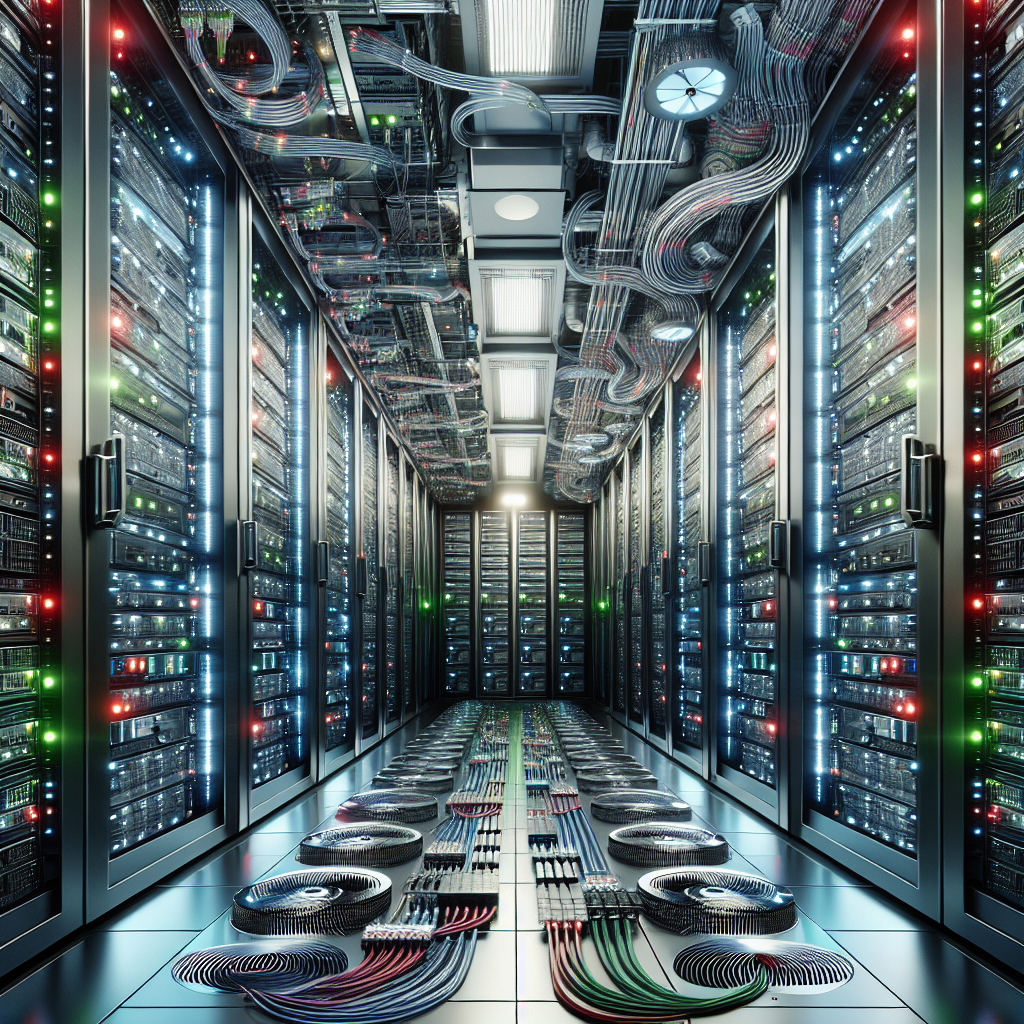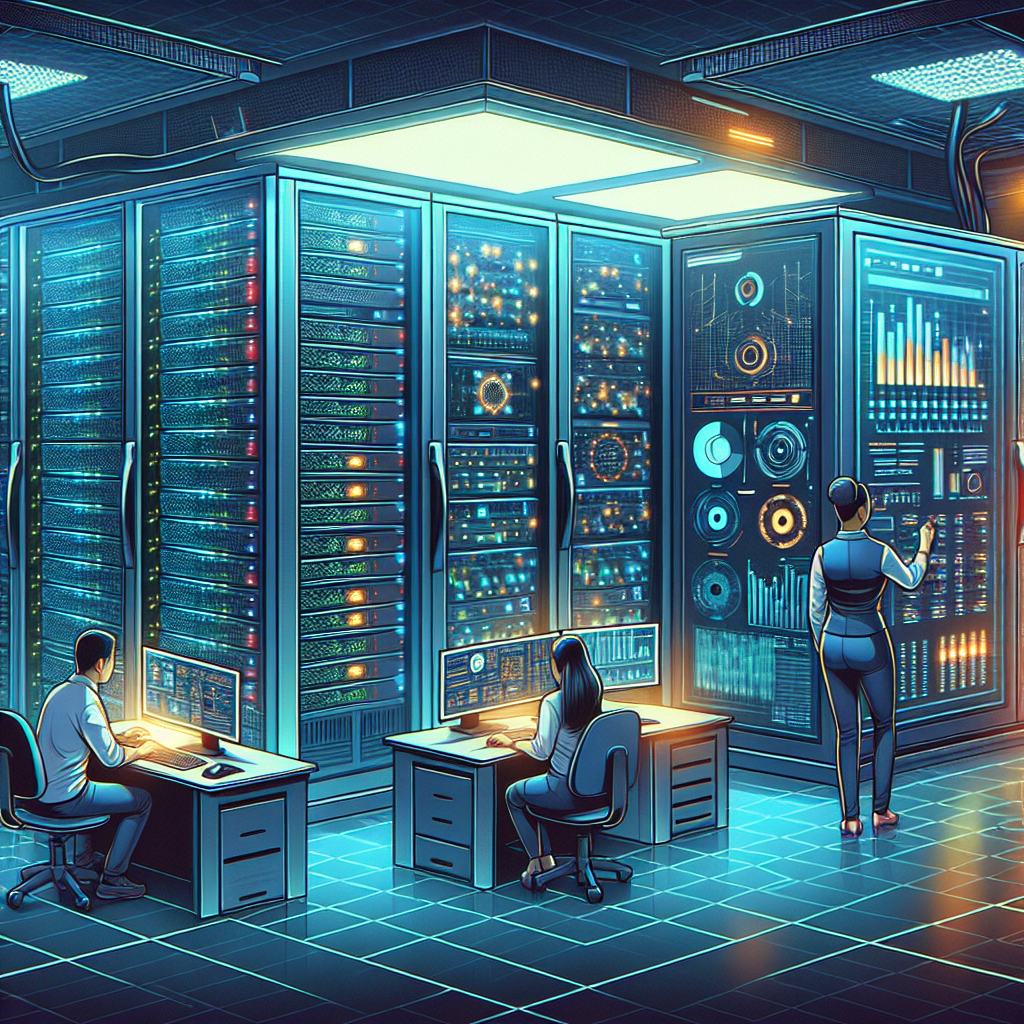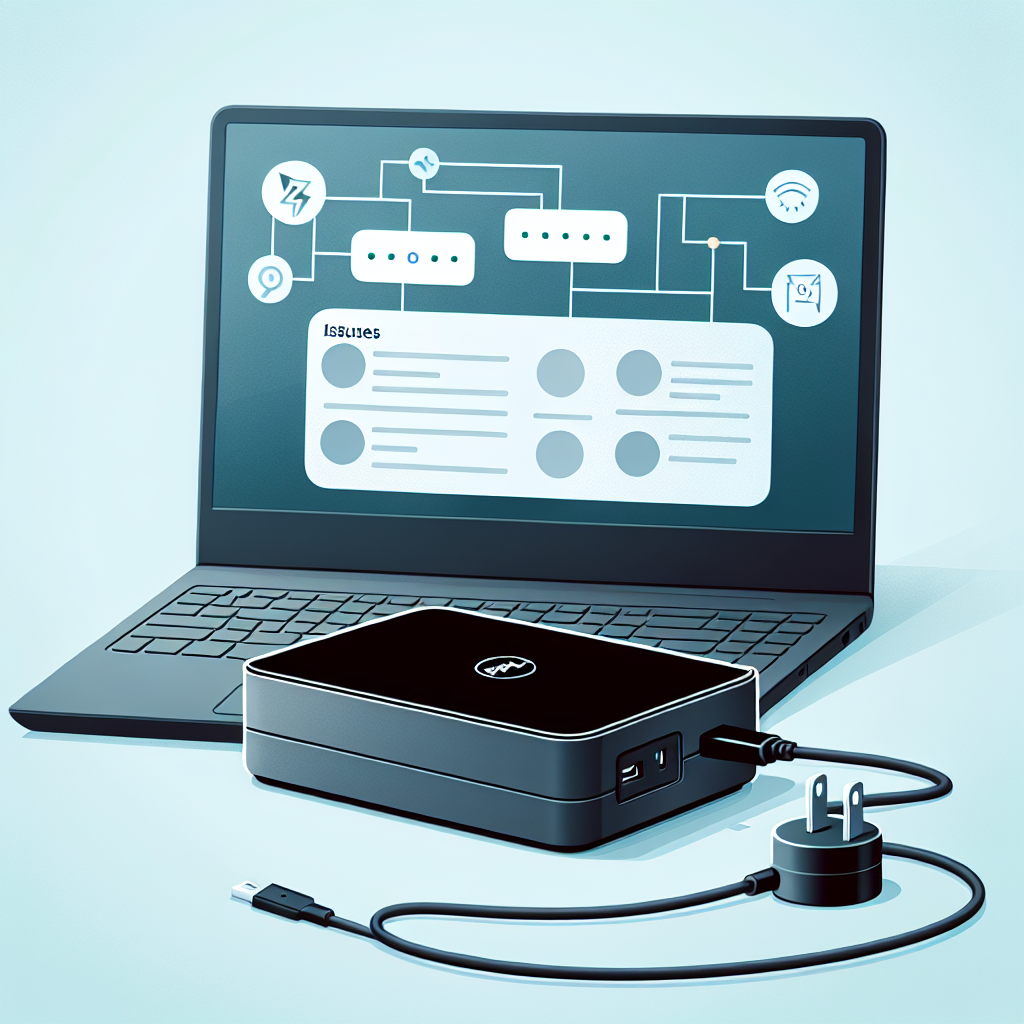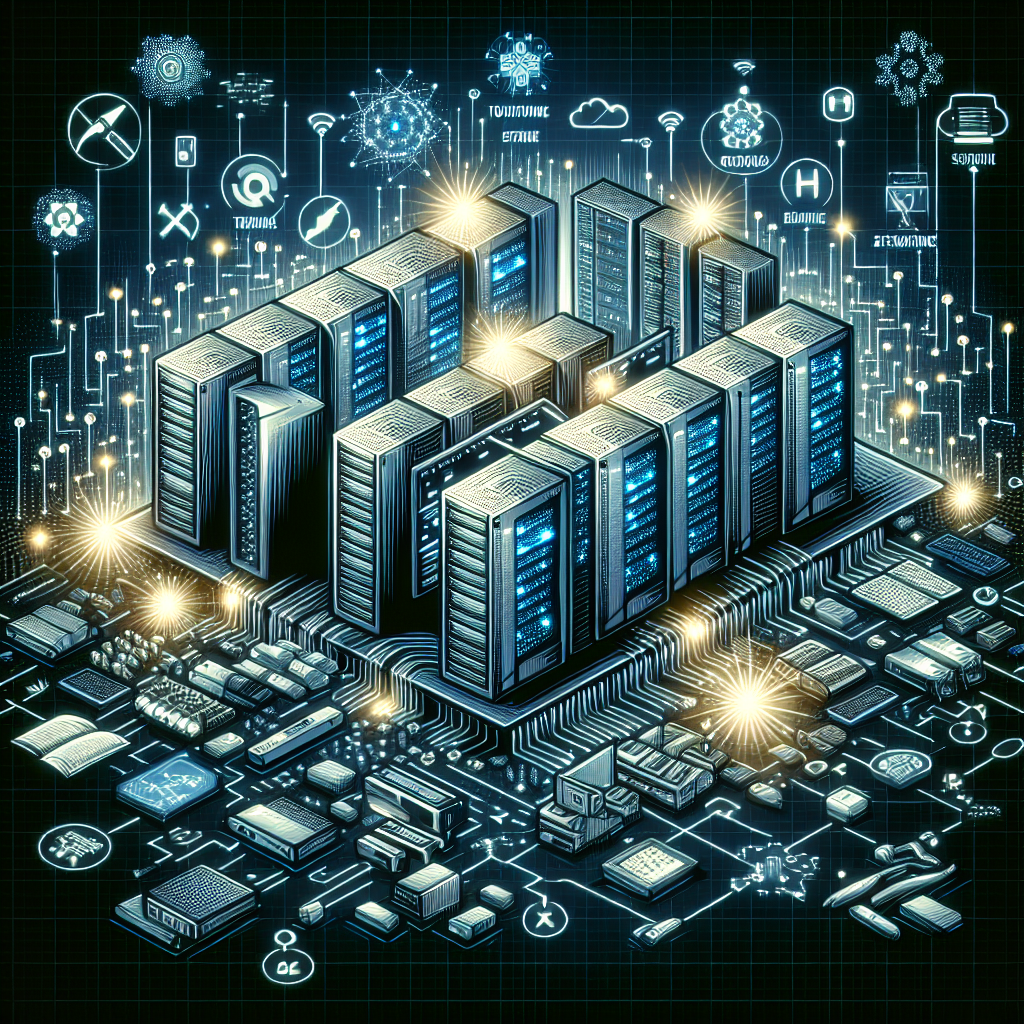Your cart is currently empty!
Tag: Troubleshooting

Troubleshooting Data Center Issues: Strategies and Solutions
Data centers are the backbone of modern businesses, storing and managing vast amounts of data critical to their operations. However, like any complex system, data centers are prone to issues that can disrupt their functioning and impact business continuity. Troubleshooting data center issues requires a systematic approach and the use of effective strategies and solutions to quickly identify and resolve problems.One of the most common issues that data centers face is power outages. These can be caused by a variety of factors such as electrical failures, equipment malfunctions, or natural disasters. To address power outages, data centers should have redundant power systems in place, such as backup generators or uninterruptible power supplies (UPS). Regular testing of these systems is essential to ensure they are functioning properly and can provide backup power when needed.
Another common issue in data centers is cooling failure. Data centers generate a significant amount of heat due to the constant operation of servers and other equipment. If cooling systems fail, the temperature inside the data center can quickly rise to dangerous levels, leading to equipment overheating and potential damage. To prevent cooling failures, data centers should have redundant cooling systems in place and regularly monitor temperature levels to detect any issues before they escalate.
Network connectivity problems are also a frequent issue in data centers. These can be caused by faulty network equipment, misconfigurations, or external factors such as network congestion or outages. To troubleshoot network connectivity issues, data center administrators should conduct thorough network diagnostics to identify the root cause of the problem. This may involve checking network configurations, testing network equipment, and working with internet service providers to resolve connectivity issues.
In addition to these common issues, data centers may also face hardware failures, software glitches, or security breaches. To effectively troubleshoot these issues, data center administrators should have a comprehensive monitoring and alerting system in place to quickly detect and respond to problems. Regular maintenance and updates of hardware and software components are also essential to prevent issues from occurring in the first place.
When troubleshooting data center issues, it is important to follow a systematic approach to identify and resolve problems effectively. This may involve gathering information about the issue, analyzing potential causes, testing solutions, and monitoring the results to ensure the problem is resolved. Collaboration with other team members and external vendors may also be necessary to leverage their expertise and resources in troubleshooting complex issues.
In conclusion, troubleshooting data center issues requires a proactive and systematic approach to quickly identify and resolve problems that can impact business operations. By implementing effective strategies and solutions, data center administrators can ensure the reliability and availability of their data center infrastructure, minimizing downtime and ensuring business continuity.

Troubleshooting Data Center Cooling and Power Management Issues: Best Practices for IT Professionals
In today’s digital age, data centers play a crucial role in storing and processing vast amounts of information for businesses and organizations. However, with the increasing demand for data storage and processing power, data centers are facing challenges in maintaining optimal temperatures and power management. These issues can lead to system downtime, reduced efficiency, and even potential data loss. In order to prevent these problems, IT professionals need to be well-versed in troubleshooting data center cooling and power management issues.One of the key factors in data center management is ensuring that the cooling systems are functioning properly. Data centers generate a significant amount of heat from the servers and other equipment, and it is essential to keep these temperatures under control to prevent overheating. IT professionals should regularly monitor the temperature levels in the data center and ensure that the cooling systems are operating efficiently. If there are any signs of overheating, such as hot spots or increased fan noise, it is important to address these issues promptly to prevent damage to the equipment.
In addition to monitoring temperature levels, IT professionals should also pay attention to power management in the data center. Power outages or fluctuations can lead to system failures and data loss, so it is important to have backup power sources in place to ensure uninterrupted operation. IT professionals should regularly test the backup power systems and ensure that they are functioning properly. In the event of a power outage, it is important to have protocols in place to safely shut down equipment and prevent data loss.
When troubleshooting data center cooling and power management issues, IT professionals should follow best practices to quickly and effectively resolve any problems that may arise. Some key best practices include:
1. Regularly monitor temperature levels and cooling system performance
2. Test backup power systems regularly and have protocols in place for power outages
3. Implement energy-efficient cooling systems to reduce heat generation
4. Use hot and cold aisle containment to optimize airflow and cooling efficiency
5. Implement power management tools to monitor energy usage and identify potential issues
6. Work with vendors and manufacturers to stay updated on the latest cooling and power management technologies
By following these best practices, IT professionals can ensure that data center cooling and power management issues are effectively addressed, leading to improved efficiency, reduced downtime, and enhanced data protection. With the increasing demand for data storage and processing power, it is more important than ever for IT professionals to be proactive in troubleshooting and managing data center cooling and power issues. By staying informed and implementing best practices, IT professionals can ensure that their data centers operate smoothly and efficiently, meeting the demands of today’s digital world.

Expert Insights: Strategies for Efficient Data Center Troubleshooting
In today’s digital age, data centers play a crucial role in storing and managing vast amounts of information for businesses and organizations. However, like any complex system, data centers can experience technical issues that can disrupt operations and lead to costly downtime. To minimize these disruptions, data center administrators must be equipped with the right strategies for efficient troubleshooting.To shed light on this topic, we reached out to industry experts to gather their insights on the best practices for data center troubleshooting. Here are some key strategies they shared:
1. Establish a Comprehensive Monitoring System: According to Chris Smith, a data center consultant, having a robust monitoring system in place is essential for quickly identifying and addressing issues in a data center. By monitoring key metrics such as temperature, power usage, and network performance, administrators can proactively detect potential problems before they escalate.
2. Document Everything: Sarah Johnson, a senior systems engineer, emphasized the importance of maintaining detailed documentation of the data center infrastructure. This includes network diagrams, equipment configurations, and troubleshooting procedures. Having this information readily available can streamline the troubleshooting process and help administrators pinpoint the root cause of issues more efficiently.
3. Conduct Regular Maintenance: John Lee, a data center manager, stressed the significance of conducting regular maintenance tasks to prevent potential issues from occurring. This includes cleaning equipment, updating software, and replacing outdated hardware. By staying proactive with maintenance, administrators can minimize the risk of unexpected downtime.
4. Collaborate with Vendors: When faced with complex technical issues, it can be beneficial to collaborate with equipment vendors for support. According to Lisa Chen, a data center architect, vendors often have specialized knowledge of their products and can provide valuable insights for troubleshooting. Establishing a good relationship with vendors can expedite the resolution of issues and ensure optimal performance of data center equipment.
5. Implement a Root Cause Analysis Process: Tim Wilson, a data center operations manager, recommended implementing a root cause analysis process to systematically identify the underlying causes of recurring issues. By conducting thorough investigations and documenting findings, administrators can implement corrective actions to prevent similar issues from reoccurring in the future.
In conclusion, efficient data center troubleshooting requires a combination of proactive monitoring, thorough documentation, regular maintenance, collaboration with vendors, and a systematic approach to root cause analysis. By implementing these strategies, data center administrators can effectively identify and resolve issues, minimize downtime, and ensure the smooth operation of their data center infrastructure.

Data Center Troubleshooting: Common Challenges and Solutions
Data centers are the backbone of modern businesses, providing the infrastructure needed to store, manage, and process data. However, like any complex system, data centers are prone to issues that can disrupt operations and cause downtime. In this article, we will discuss some common challenges that data center operators face and provide solutions for troubleshooting them.One of the most common challenges that data center operators face is cooling issues. Data centers generate a significant amount of heat due to the high power density of the equipment housed within them. If the cooling system is not functioning properly, this heat can build up and cause equipment to overheat, leading to performance degradation or even equipment failure.
To troubleshoot cooling issues, data center operators should first check the temperature and humidity levels in the data center. If they are outside of the recommended range, adjustments may need to be made to the cooling system. This could involve increasing airflow, adjusting the temperature set points on the cooling units, or adding additional cooling capacity.
Another common challenge in data centers is power outages. Data centers rely on a constant supply of electricity to keep the equipment running, and any interruption in power can lead to downtime and data loss. To troubleshoot power outages, data center operators should first check the power source to ensure that it is functioning properly. They should also check the UPS (Uninterruptible Power Supply) system to ensure that it is providing backup power in the event of a power outage.
Network connectivity issues are also a common challenge in data centers. If servers are unable to communicate with each other or with external networks, it can disrupt operations and cause downtime. To troubleshoot network connectivity issues, data center operators should check the network cables and switches to ensure they are properly connected and functioning. They should also check the network configuration to ensure that it is set up correctly.
Security breaches are another common challenge in data centers. With the increasing threat of cyber attacks, data center operators need to be vigilant in protecting their data and infrastructure from malicious actors. To troubleshoot security breaches, data center operators should regularly update their security protocols and software to protect against the latest threats. They should also conduct regular security audits to identify and address any vulnerabilities in their systems.
In conclusion, data center troubleshooting can be a complex and challenging task, but by being proactive and diligent in monitoring and maintaining the data center infrastructure, operators can minimize downtime and ensure that their data center remains operational and secure. By addressing common challenges such as cooling issues, power outages, network connectivity issues, and security breaches, data center operators can keep their data center running smoothly and efficiently.

The Role of Data Center Monitoring in Troubleshooting and Resolving Issues
Data centers play a crucial role in the operations of businesses and organizations, as they house and manage the critical IT infrastructure that supports their day-to-day activities. With the increasing complexity and scale of data centers, monitoring has become an essential tool for ensuring the smooth and efficient operation of these facilities.Data center monitoring involves the continuous tracking and analysis of various parameters such as temperature, humidity, power consumption, network performance, and server health. By monitoring these metrics in real-time, data center managers can identify potential issues before they escalate into serious problems that could disrupt operations.
One of the key benefits of data center monitoring is its role in troubleshooting and resolving issues. By constantly monitoring the performance of the data center infrastructure, IT staff can quickly identify any abnormalities or deviations from normal operation. For example, if a server is experiencing high CPU usage or if a cooling system is not functioning properly, monitoring tools can alert IT staff to investigate and address the issue promptly.
In addition, data center monitoring can also help in identifying trends and patterns that could indicate potential problems in the future. By analyzing historical data and performance trends, data center managers can proactively address issues before they impact the overall operation of the facility.
Furthermore, data center monitoring can also play a crucial role in ensuring compliance with industry regulations and standards. By monitoring and documenting various parameters such as temperature, humidity, and power consumption, data center managers can demonstrate compliance with regulatory requirements and best practices.
Overall, data center monitoring is an essential tool for ensuring the efficient and reliable operation of data centers. By continuously monitoring and analyzing key performance metrics, data center managers can quickly identify and resolve issues, proactively address potential problems, and ensure compliance with industry standards. In today’s fast-paced and highly competitive business environment, data center monitoring is a critical component of maintaining a reliable and secure IT infrastructure.

Avoiding Data Center Downtime: Tips for Proactive Troubleshooting
Data center downtime can be a nightmare for businesses, resulting in lost revenue, damaged reputation, and frustrated customers. To avoid these costly disruptions, it is essential to take proactive measures to troubleshoot potential issues before they escalate into full-blown outages. Here are some tips for proactive troubleshooting to keep your data center up and running smoothly.1. Regularly monitor and maintain equipment: One of the most effective ways to prevent downtime is to regularly monitor and maintain your data center equipment. This includes conducting routine inspections, checking for signs of wear and tear, and performing necessary maintenance tasks such as cleaning, updating firmware, and replacing faulty components. By staying on top of equipment maintenance, you can catch potential issues before they cause a major problem.
2. Implement monitoring tools: Investing in monitoring tools can help you keep a close eye on the health and performance of your data center. These tools can provide real-time alerts for issues such as overheating, power fluctuations, or network congestion, allowing you to address them quickly before they lead to downtime. By proactively monitoring your data center, you can identify and resolve issues before they impact your operations.
3. Conduct regular backups: Data loss can be a major cause of downtime, so it is essential to regularly back up your data to prevent potential disasters. Implementing a robust backup strategy can help you recover quickly in the event of a data center outage, minimizing the impact on your business. Make sure to test your backups regularly to ensure they are functioning properly and can be restored quickly in case of an emergency.
4. Develop a comprehensive disaster recovery plan: In addition to regular backups, it is crucial to have a comprehensive disaster recovery plan in place to handle unexpected outages. This plan should outline the steps to take in the event of a data center failure, including how to restore operations, communicate with stakeholders, and mitigate the impact on your business. By having a well-thought-out disaster recovery plan, you can minimize downtime and ensure a swift recovery in the face of a crisis.
5. Train your staff: Your data center staff play a critical role in maintaining the health and performance of your infrastructure. Make sure they are properly trained on best practices for troubleshooting, maintenance, and disaster recovery. By empowering your team with the knowledge and skills they need to address issues proactively, you can reduce the risk of downtime and keep your data center running smoothly.
In conclusion, avoiding data center downtime requires a proactive approach to troubleshooting and maintenance. By implementing these tips and staying vigilant in monitoring and maintaining your data center, you can minimize the risk of outages and ensure the continuity of your operations. Remember, prevention is always better than cure when it comes to data center downtime.

Troubleshooting Common Issues with the Dell DA240PM200 Charger
The Dell DA240PM200 charger is a powerful and reliable accessory that is designed to keep your Dell laptop running smoothly. However, like any electronic device, it can sometimes encounter issues that may prevent it from working properly. In this article, we will discuss some common problems with the Dell DA240PM200 charger and provide troubleshooting tips to help you resolve them.One of the most common issues with the Dell DA240PM200 charger is that it may not be charging your laptop properly. If you find that your laptop is not charging when connected to the charger, the first thing you should do is check the power cord and the connection between the charger and the laptop. Make sure that the power cord is securely plugged into both the charger and the wall outlet, and that the connection between the charger and the laptop is secure.
If the power cord and connection are fine, the next step is to check the charger itself. Inspect the charger for any signs of damage, such as frayed wires or bent prongs. If you notice any damage, you may need to replace the charger.
Another common issue with the Dell DA240PM200 charger is that it may be overheating. If you notice that the charger is excessively hot to the touch, it may be overheating, which can cause it to malfunction. To resolve this issue, try unplugging the charger and letting it cool down for a few minutes before plugging it back in. You should also make sure that the charger is placed in a well-ventilated area to prevent overheating.
If your Dell DA240PM200 charger is still not working properly after trying these troubleshooting tips, it may be time to contact Dell customer support for further assistance. They can help you diagnose the issue and provide you with a solution to get your charger working again.
In conclusion, the Dell DA240PM200 charger is a reliable accessory that can help keep your Dell laptop charged and ready to go. However, if you encounter any issues with your charger, it is important to troubleshoot the problem and resolve it as soon as possible to prevent any further damage. By following the tips outlined in this article, you can ensure that your Dell DA240PM200 charger continues to work properly and keep your laptop powered up.

The Benefits of Using a Wowpc Recovery USB for Quick and Easy Troubleshooting
In today’s fast-paced world, technology plays a crucial role in our daily lives. From smartphones to laptops, we rely on electronic devices for work, communication, and entertainment. However, with the increasing complexity of technology, issues and problems can arise that may disrupt our workflow or cause frustration.One common issue that many computer users face is the dreaded blue screen of death or system crash. When this happens, it can be a nightmare trying to troubleshoot the problem and get your computer back up and running. This is where a Wowpc Recovery USB can come in handy.
A Wowpc Recovery USB is a portable device that contains a pre-loaded operating system and a variety of troubleshooting tools. By simply plugging the USB into your computer, you can boot up the system and access a range of diagnostic and repair tools that can help you quickly identify and fix the issue.
One of the main benefits of using a Wowpc Recovery USB is its convenience. Instead of having to lug around a bulky computer or spend hours trying to troubleshoot the problem on your own, you can simply plug in the USB and let the system do the work for you. This can save you time and frustration, allowing you to get back to work or play in no time.
Another benefit of using a Wowpc Recovery USB is its versatility. Whether you are a tech-savvy individual or a novice computer user, the USB contains tools and resources that can help you troubleshoot a wide range of issues. From repairing corrupted files to removing viruses and malware, the USB provides you with everything you need to get your computer back up and running smoothly.
Additionally, using a Wowpc Recovery USB can help you save money on expensive repair services. Instead of having to take your computer to a professional technician, you can use the USB to diagnose and fix the issue on your own. This can save you time and money, allowing you to get back to using your computer without breaking the bank.
In conclusion, a Wowpc Recovery USB is a valuable tool for anyone who relies on technology in their daily lives. With its ease of use, versatility, and cost-saving benefits, the USB can help you quickly troubleshoot and fix issues with your computer. Whether you are a business professional or a casual computer user, having a Wowpc Recovery USB on hand can provide you with peace of mind and ensure that you are always prepared for any technical issues that may arise.

Data Center Troubleshooting 101: How to Identify and Resolve Network Problems
A data center is the nerve center of any organization, housing servers, storage devices, and networking equipment that are crucial for daily operations. When network problems arise in a data center, it can have a significant impact on productivity and efficiency. Therefore, it is important for data center administrators to be able to quickly identify and resolve network problems to minimize downtime and ensure smooth operations.Here are some tips for troubleshooting network problems in a data center:
1. Identify the problem: The first step in troubleshooting network problems is to identify the source of the issue. This can be done by checking network logs, monitoring tools, and speaking to users to determine when the problem started and what specific symptoms are being experienced.
2. Check network connections: One of the most common causes of network problems in a data center is a loose or faulty network connection. Check all physical connections to ensure they are secure and properly connected. If necessary, replace any damaged cables or connectors.
3. Test network equipment: If network connections appear to be in good condition, the next step is to test network equipment such as switches, routers, and servers. Use network testing tools to check for connectivity and performance issues, and replace or reconfigure any faulty equipment.
4. Monitor network traffic: High network traffic can cause congestion and slow down data transfer speeds. Use network monitoring tools to track network traffic and identify any bottlenecks or areas of high usage. Adjust network settings or upgrade equipment as needed to improve performance.
5. Update firmware and software: Outdated firmware and software can also cause network problems in a data center. Regularly check for updates and patches for network equipment and applications, and install them as soon as they become available to ensure optimal performance and security.
6. Check for security breaches: Network problems could also be a result of a security breach or cyber attack. Monitor network traffic for any suspicious activity, such as unauthorized access attempts or unusual data transfers. Implement security measures such as firewalls and intrusion detection systems to protect against potential threats.
7. Seek help from experts: If you are unable to identify or resolve network problems on your own, don’t hesitate to seek help from network specialists or IT support professionals. They have the expertise and tools to diagnose and fix complex network issues quickly and effectively.
By following these troubleshooting tips, data center administrators can effectively identify and resolve network problems to ensure the smooth operation of their organization’s critical infrastructure. Being proactive in addressing network issues can help minimize downtime, improve performance, and enhance the overall reliability of the data center.

Troubleshooting Data Center Performance Issues: A Step-by-Step Guide
Data centers are the backbone of modern businesses, providing the necessary infrastructure to store and manage critical data and applications. However, even the most advanced data centers can encounter performance issues that can disrupt operations and impact productivity. Troubleshooting these issues requires a methodical approach to identify and resolve the root cause of the problem. In this step-by-step guide, we will outline the key steps to troubleshooting data center performance issues.Step 1: Define the Problem
The first step in troubleshooting data center performance issues is to clearly define the problem. This may involve gathering information from users, monitoring tools, or system logs to identify the symptoms of the issue. Common performance issues in data centers may include slow application response times, high CPU or memory utilization, network congestion, or storage bottlenecks.
Step 2: Identify the Scope
Once the problem has been defined, it is important to identify the scope of the issue. This may involve determining whether the performance issue is isolated to a specific server, application, or network segment, or if it is affecting the entire data center. Understanding the scope of the issue will help to narrow down potential causes and prioritize troubleshooting efforts.
Step 3: Gather Data
To troubleshoot data center performance issues effectively, it is essential to gather relevant data and metrics. This may involve monitoring system performance using tools such as network monitoring software, server monitoring tools, or application performance monitoring (APM) solutions. By collecting data on key performance indicators (KPIs) such as CPU utilization, network latency, and disk I/O, IT teams can gain insights into the underlying causes of performance issues.
Step 4: Analyze the Data
Once data has been collected, the next step is to analyze the data to identify patterns or anomalies that may be contributing to the performance issue. This may involve correlating data from different sources, comparing historical performance metrics, or conducting root cause analysis to pinpoint the underlying cause of the problem. By analyzing the data systematically, IT teams can identify the specific components of the data center infrastructure that are causing performance degradation.
Step 5: Troubleshoot the Issue
After identifying the root cause of the performance issue, the next step is to troubleshoot the problem and implement a solution. This may involve adjusting configuration settings, applying software patches, upgrading hardware components, or optimizing network traffic. It is important to follow best practices and industry standards when troubleshooting data center performance issues to ensure that changes do not inadvertently introduce new problems.
Step 6: Monitor and Test
Once a solution has been implemented, it is important to monitor the data center performance to ensure that the issue has been resolved. This may involve conducting performance tests, monitoring system logs, or using APM tools to track application performance. By continuously monitoring and testing the data center infrastructure, IT teams can proactively identify and address performance issues before they impact business operations.
In conclusion, troubleshooting data center performance issues requires a systematic approach to identify and resolve the root cause of the problem. By following these steps, IT teams can effectively diagnose and troubleshoot performance issues in data centers, ensuring that critical business applications and services remain operational and reliable.
